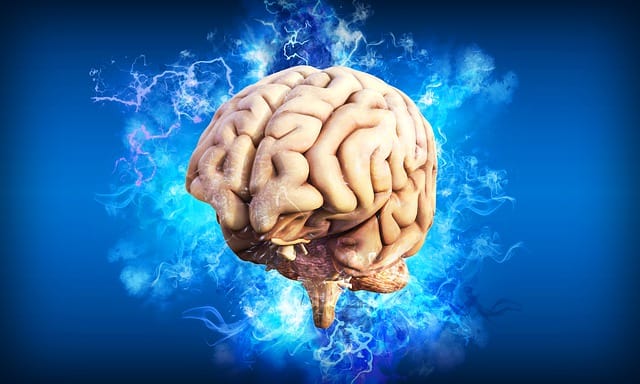Entering into the alpha state of mind more often offers a range of benefits for intuitive living, from boosting creativity to enhancing intuition and decision-making.

What are alpha waves?
Alpha brain waves are neural oscillations at a frequency of approximately between 8 and 13 Hz (or cycles per second). This is your brain’s electrical rhythm when you are in a state of “wakeful relaxation”. 1
Also referred to as the alpha rhythm, it is one of several brain frequency types (see below).
Alpha brain waves are associated with a relaxed and meditative state of mind. When you are in this state, you are able to focus on the present moment and tune out distractions. This allows you to tap into your intuition and inner wisdom more easily.
At entry of the alpha oscillations, the vibration of the electric currents in your brain slows.
What Does Alpha State Feel Like?
I describe it as being in ‘the flow’, a state of calm. Some describe the alpha state as a light hypnotic state. You are awake but very relaxed.
Some people might describe it as being in ‘Zen’.
Alpha Brainwave Benefits for Intuitive Living
States of calm and happiness are reported.
Benefits of alpha brain waves for intuitive living:
- Increased creativity: Alpha brain waves are associated with moments of insight and inspiration, leading to more creative and innovative thinking.
- Improved concentration: By inducing alpha brain waves, you can improve your focus and attention, allowing you to tune out distractions and stay on task.
- Increased relaxation: Alpha brain waves are also associated with a state of relaxation, which can help reduce stress and anxiety, and according to Psychology Today, helps reduce depression.
- Enhanced intuition: Alpha brain waves can help you tap into your intuition and inner wisdom, leading to better decision-making and problem-solving skills.
- Improved learning: Alpha brain waves are also associated with a state of learning readiness, making it easier for individuals to absorb and retain new information.
- Re-energizing: Turning off the beta waves and entering the alpha state gets you ready for a sound night’s sleep, which recharges you for the next day’s activities.
Apart from insight and intuition, other benefits described are improved cognitive thinking and recall.2
By practicing techniques such as meditation or mindfulness, you can train your brain to produce more alpha waves on a regular basis. This can help you feel more calm and centered, which in turn supports your ability to live intuitively.
Thus, cultivating alpha brain waves can be a powerful tool for living a more intuitive and fulfilling life.
How To Enter Alpha State Of Mind
Entering the alpha state means quietening the mind. Meditation is a practice associated with alpha brain waves.
Some people enter this state while gazing into space or at the Moon.
Other ways you (sometimes unknowingly) might enter the alpha state of mind is during activities that allow you to ‘zone out’. Puzzles, adult coloring, or other similar hobbies, for example, are ways you can zone out.
Brain Wave Types Explained
Brain waves are measured in hertz (Hz) or cycles per second (cps). One hertz equals one cps.
What are the 4 types of brain waves? Writers mostly refer to four brain waves: delta at less than 4 cps, theta from 4 to 7 cps, alpha at 7 to 14 cps, and beta above 14 cps. 4
We now have digital electroencephalography (EEG) technology to measure brain activity and record views of brain oscillations.
Since the use of EEG, science today recognizes five human brain waves: delta (0.5-3 Hz), theta (3.5-7 Hz), alpha (8-13 Hz), beta (13-30 Hz), and gamma (30-100 Hz). 5
Gamma
Advanced practitioners of meditation have been found to display increased gamma activity.
This stuff happens without our control or awareness.
Delta
Delta waves are associated with the deepest sleep.
Theta
Increased theta levels are associated with the unconscious or subconscious mind, we are likely to exhibit this in hypnosis.6, 7
Alpha
In REM sleep or light sleep, our brains are in an alpha state. In deep sleep (the dreamless type), we enter the delta and theta states.
We experience the alpha state of mind frequency when we are daydreaming or consciously practicing mindfulness or meditation or other times when we are in the flow — on automatic.
An experiment on Einstein recording his brain oscillations revealed he entered this flow or alpha state when working on rather complex mathematical calculations. 3
Beta
We are in a beta state of mind when wide awake and operating in today’s fast-paced lifestyle.
What to Watch
You know how time disappears when you are using social media networks. You might not realize it, but you enter a trance-like state.
Platforms such as FB are aware of brain science technology and that tapping into your brain waves can improve your experience while improving their targeting of ads.
This is something to be aware of as we are entering a time where it is no longer the stuff of sci-fi movies.
References
- Alpha wave. 2019. In Merriam-Webster Online Dictionary. Retrieved Aug 2, 2019.
- Kounios, J., Fleck, J. I., Green, D. L., Payne, L., Stevenson, J. L., Bowden, E. M., & Jung-Beeman, M. (2007). The origins of insight in resting-state brain activity. Neuropsychologia, 46(1), 281-91.
- Penfield & Jasper, 1954. Epilepsy and the Functional Anatomy of the Human Brain. pp. 189-90.
- Silva, J. Jr., Bernd, E. Jr. 2007. Jose Silva’s Everyday ESP. New Page Books, New Jersey.
- Lee D. J., Kulubya E., Goldin P., Goodarzi A., Girgis F. 2018. Review of the Neural Oscillations Underlying Meditation Front. Neurosci., 26 March 2018 https://doi.org/10.3389/fnins.2018.00178
- Sabourin, M. E., Cutcomb, S. D., Crawford, H. J., & Pribram, K. (1990). EEG correlates of hypnotic susceptibility and hypnotic trance: Spectral analysis and coherence. International Journal of Psychophysiology, 10(2), 125-142.
- Jensen, M. P., Adachi, T., & Hakimian, S. (2015). Brain Oscillations, Hypnosis, and Hypnotizability. The American journal of clinical hypnosis, 57(3), 230-253.



